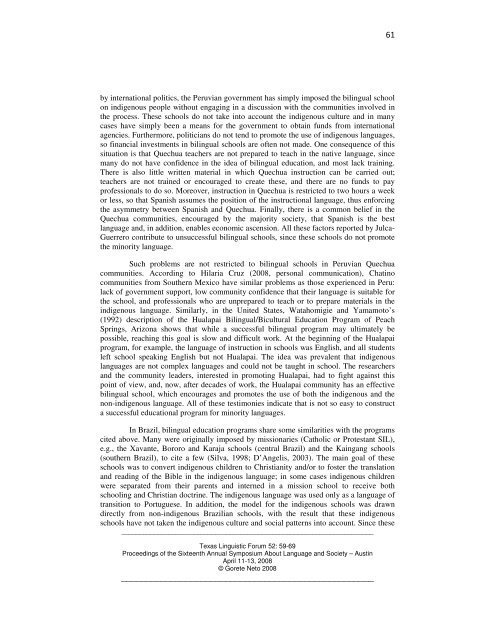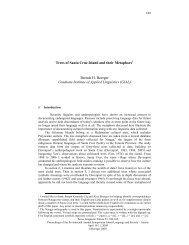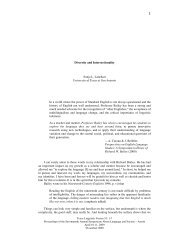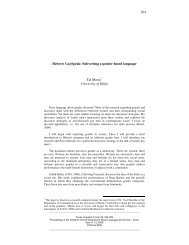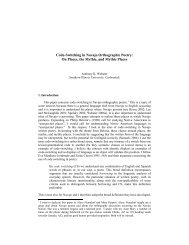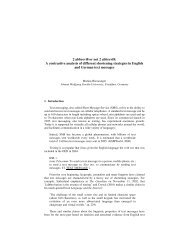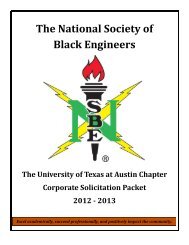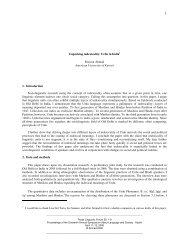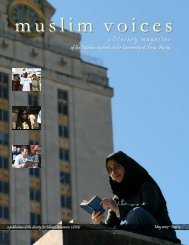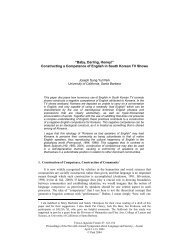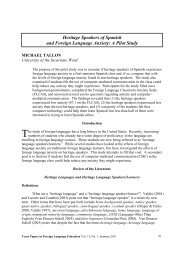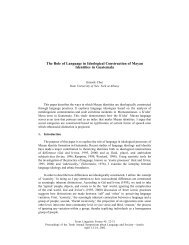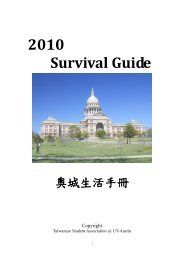The Impact of Bilingual Education on Indigenous Language and ...
The Impact of Bilingual Education on Indigenous Language and ...
The Impact of Bilingual Education on Indigenous Language and ...
You also want an ePaper? Increase the reach of your titles
YUMPU automatically turns print PDFs into web optimized ePapers that Google loves.
y internati<strong>on</strong>al politics, the Peruvian government has simply imposed the bilingual school<br />
<strong>on</strong> indigenous people without engaging in a discussi<strong>on</strong> with the communities involved in<br />
the process. <str<strong>on</strong>g>The</str<strong>on</strong>g>se schools do not take into account the indigenous culture <strong>and</strong> in many<br />
cases have simply been a means for the government to obtain funds from internati<strong>on</strong>al<br />
agencies. Furthermore, politicians do not tend to promote the use <str<strong>on</strong>g>of</str<strong>on</strong>g> indigenous languages,<br />
so financial investments in bilingual schools are <str<strong>on</strong>g>of</str<strong>on</strong>g>ten not made. One c<strong>on</strong>sequence <str<strong>on</strong>g>of</str<strong>on</strong>g> this<br />
situati<strong>on</strong> is that Quechua teachers are not prepared to teach in the native language, since<br />
many do not have c<strong>on</strong>fidence in the idea <str<strong>on</strong>g>of</str<strong>on</strong>g> bilingual educati<strong>on</strong>, <strong>and</strong> most lack training.<br />
<str<strong>on</strong>g>The</str<strong>on</strong>g>re is also little written material in which Quechua instructi<strong>on</strong> can be carried out;<br />
teachers are not trained or encouraged to create these, <strong>and</strong> there are no funds to pay<br />
pr<str<strong>on</strong>g>of</str<strong>on</strong>g>essi<strong>on</strong>als to do so. Moreover, instructi<strong>on</strong> in Quechua is restricted to two hours a week<br />
or less, so that Spanish assumes the positi<strong>on</strong> <str<strong>on</strong>g>of</str<strong>on</strong>g> the instructi<strong>on</strong>al language, thus enforcing<br />
the asymmetry between Spanish <strong>and</strong> Quechua. Finally, there is a comm<strong>on</strong> belief in the<br />
Quechua communities, encouraged by the majority society, that Spanish is the best<br />
language <strong>and</strong>, in additi<strong>on</strong>, enables ec<strong>on</strong>omic ascensi<strong>on</strong>. All these factors reported by Julca-<br />
Guerrero c<strong>on</strong>tribute to unsuccessful bilingual schools, since these schools do not promote<br />
the minority language.<br />
Such problems are not restricted to bilingual schools in Peruvian Quechua<br />
communities. According to Hilaria Cruz (2008, pers<strong>on</strong>al communicati<strong>on</strong>), Chatino<br />
communities from Southern Mexico have similar problems as those experienced in Peru:<br />
lack <str<strong>on</strong>g>of</str<strong>on</strong>g> government support, low community c<strong>on</strong>fidence that their language is suitable for<br />
the school, <strong>and</strong> pr<str<strong>on</strong>g>of</str<strong>on</strong>g>essi<strong>on</strong>als who are unprepared to teach or to prepare materials in the<br />
indigenous language. Similarly, in the United States, Watahomigie <strong>and</strong> Yamamoto’s<br />
(1992) descripti<strong>on</strong> <str<strong>on</strong>g>of</str<strong>on</strong>g> the Hualapai <str<strong>on</strong>g>Bilingual</str<strong>on</strong>g>/Bicultural <str<strong>on</strong>g>Educati<strong>on</strong></str<strong>on</strong>g> Program <str<strong>on</strong>g>of</str<strong>on</strong>g> Peach<br />
Springs, Ariz<strong>on</strong>a shows that while a successful bilingual program may ultimately be<br />
possible, reaching this goal is slow <strong>and</strong> difficult work. At the beginning <str<strong>on</strong>g>of</str<strong>on</strong>g> the Hualapai<br />
program, for example, the language <str<strong>on</strong>g>of</str<strong>on</strong>g> instructi<strong>on</strong> in schools was English, <strong>and</strong> all students<br />
left school speaking English but not Hualapai. <str<strong>on</strong>g>The</str<strong>on</strong>g> idea was prevalent that indigenous<br />
languages are not complex languages <strong>and</strong> could not be taught in school. <str<strong>on</strong>g>The</str<strong>on</strong>g> researchers<br />
<strong>and</strong> the community leaders, interested in promoting Hualapai, had to fight against this<br />
point <str<strong>on</strong>g>of</str<strong>on</strong>g> view, <strong>and</strong>, now, after decades <str<strong>on</strong>g>of</str<strong>on</strong>g> work, the Hualapai community has an effective<br />
bilingual school, which encourages <strong>and</strong> promotes the use <str<strong>on</strong>g>of</str<strong>on</strong>g> both the indigenous <strong>and</strong> the<br />
n<strong>on</strong>-indigenous language. All <str<strong>on</strong>g>of</str<strong>on</strong>g> these testim<strong>on</strong>ies indicate that is not so easy to c<strong>on</strong>struct<br />
a successful educati<strong>on</strong>al program for minority languages.<br />
In Brazil, bilingual educati<strong>on</strong> programs share some similarities with the programs<br />
cited above. Many were originally imposed by missi<strong>on</strong>aries (Catholic or Protestant SIL),<br />
e.g., the Xavante, Bororo <strong>and</strong> Karaja schools (central Brazil) <strong>and</strong> the Kaingang schools<br />
(southern Brazil), to cite a few (Silva, 1998; D’Angelis, 2003). <str<strong>on</strong>g>The</str<strong>on</strong>g> main goal <str<strong>on</strong>g>of</str<strong>on</strong>g> these<br />
schools was to c<strong>on</strong>vert indigenous children to Christianity <strong>and</strong>/or to foster the translati<strong>on</strong><br />
<strong>and</strong> reading <str<strong>on</strong>g>of</str<strong>on</strong>g> the Bible in the indigenous language; in some cases indigenous children<br />
were separated from their parents <strong>and</strong> interned in a missi<strong>on</strong> school to receive both<br />
schooling <strong>and</strong> Christian doctrine. <str<strong>on</strong>g>The</str<strong>on</strong>g> indigenous language was used <strong>on</strong>ly as a language <str<strong>on</strong>g>of</str<strong>on</strong>g><br />
transiti<strong>on</strong> to Portuguese. In additi<strong>on</strong>, the model for the indigenous schools was drawn<br />
directly from n<strong>on</strong>-indigenous Brazilian schools, with the result that these indigenous<br />
schools have not taken the indigenous culture <strong>and</strong> social patterns into account. Since these<br />
______________________________________________________________________<br />
Texas Linguistic Forum 52: 59-69<br />
Proceedings <str<strong>on</strong>g>of</str<strong>on</strong>g> the Sixteenth Annual Symposium About <strong>Language</strong> <strong>and</strong> Society – Austin<br />
April 11-13, 2008<br />
© Gorete Neto 2008<br />
___________________________________________________<br />
61


